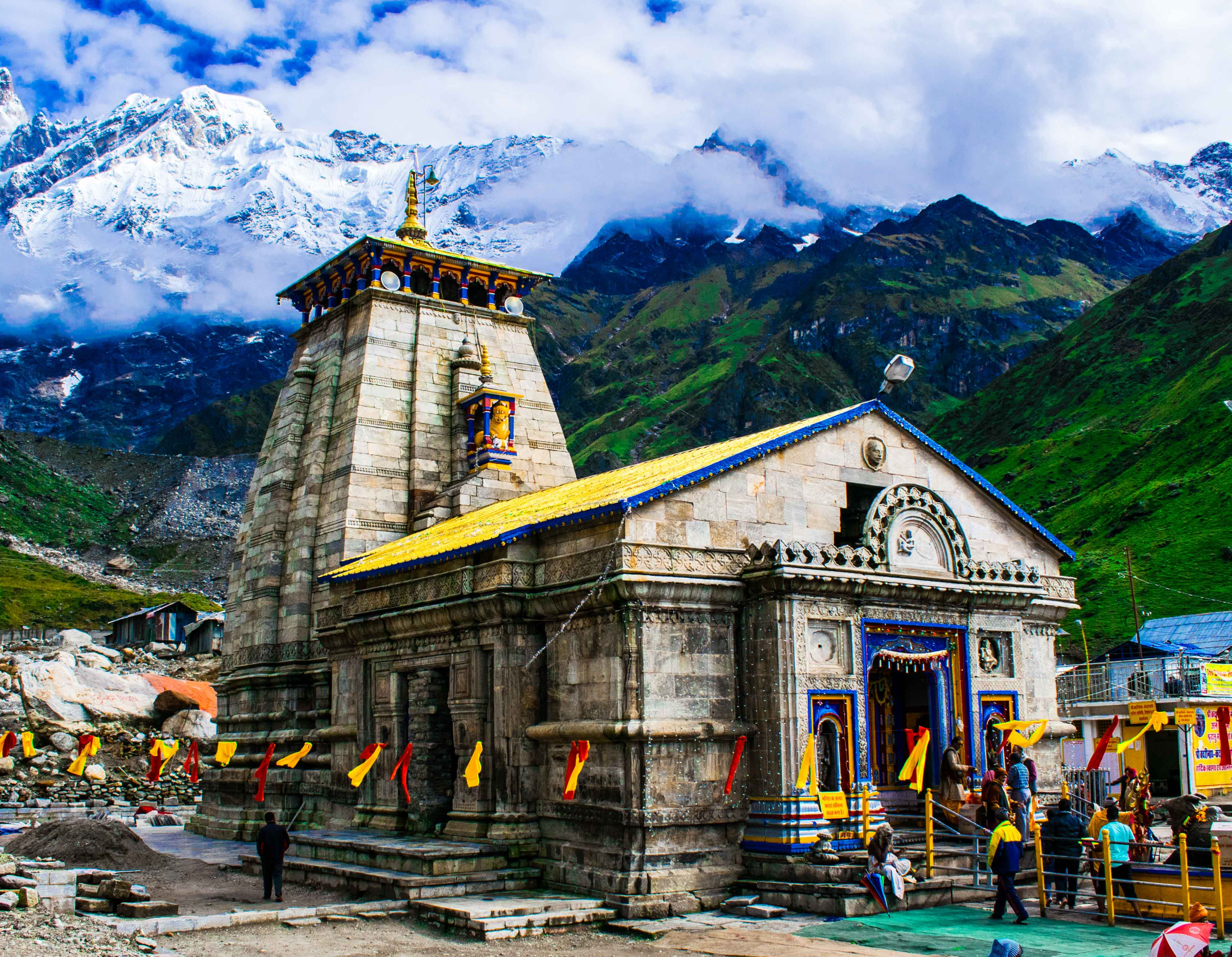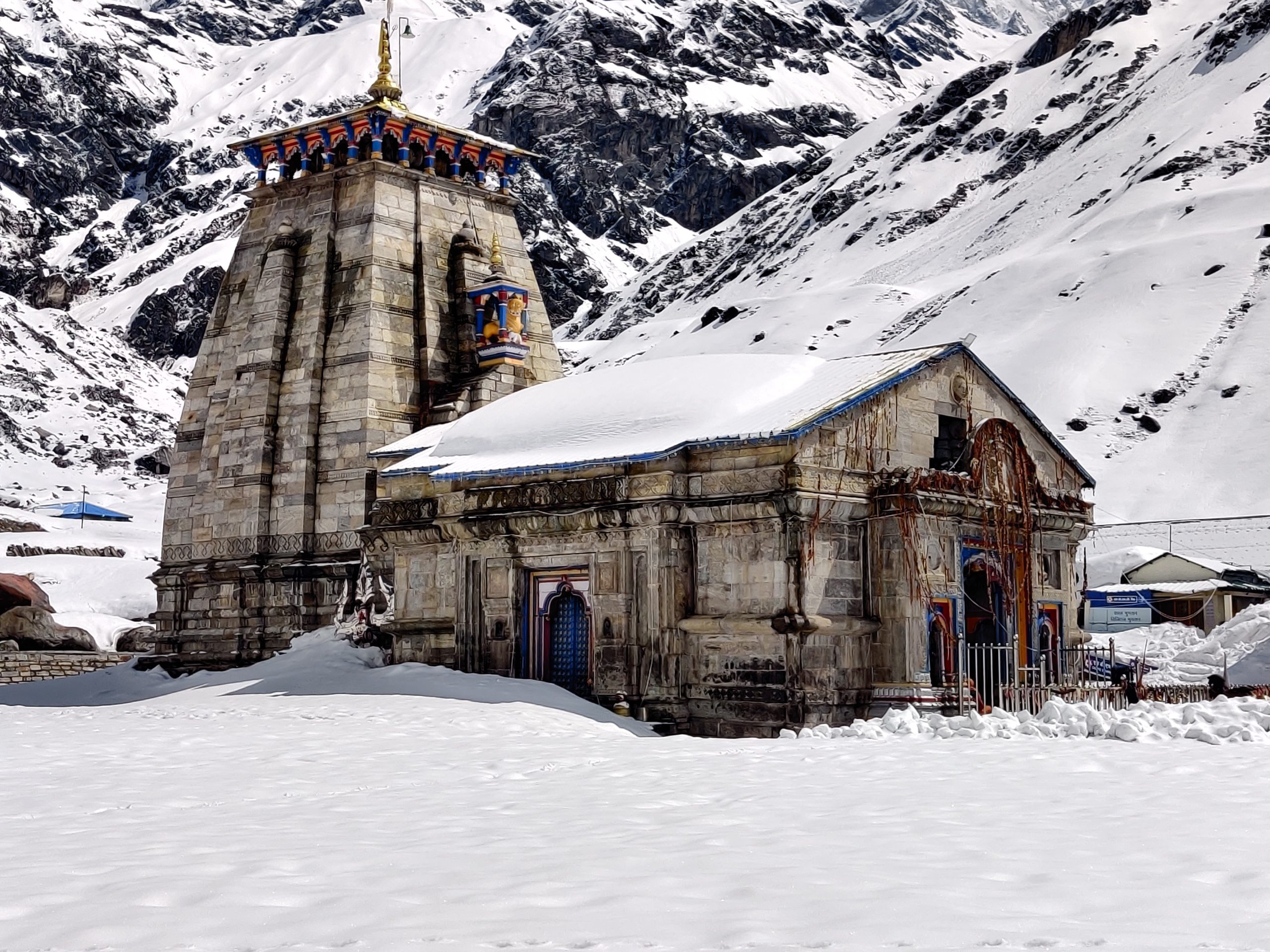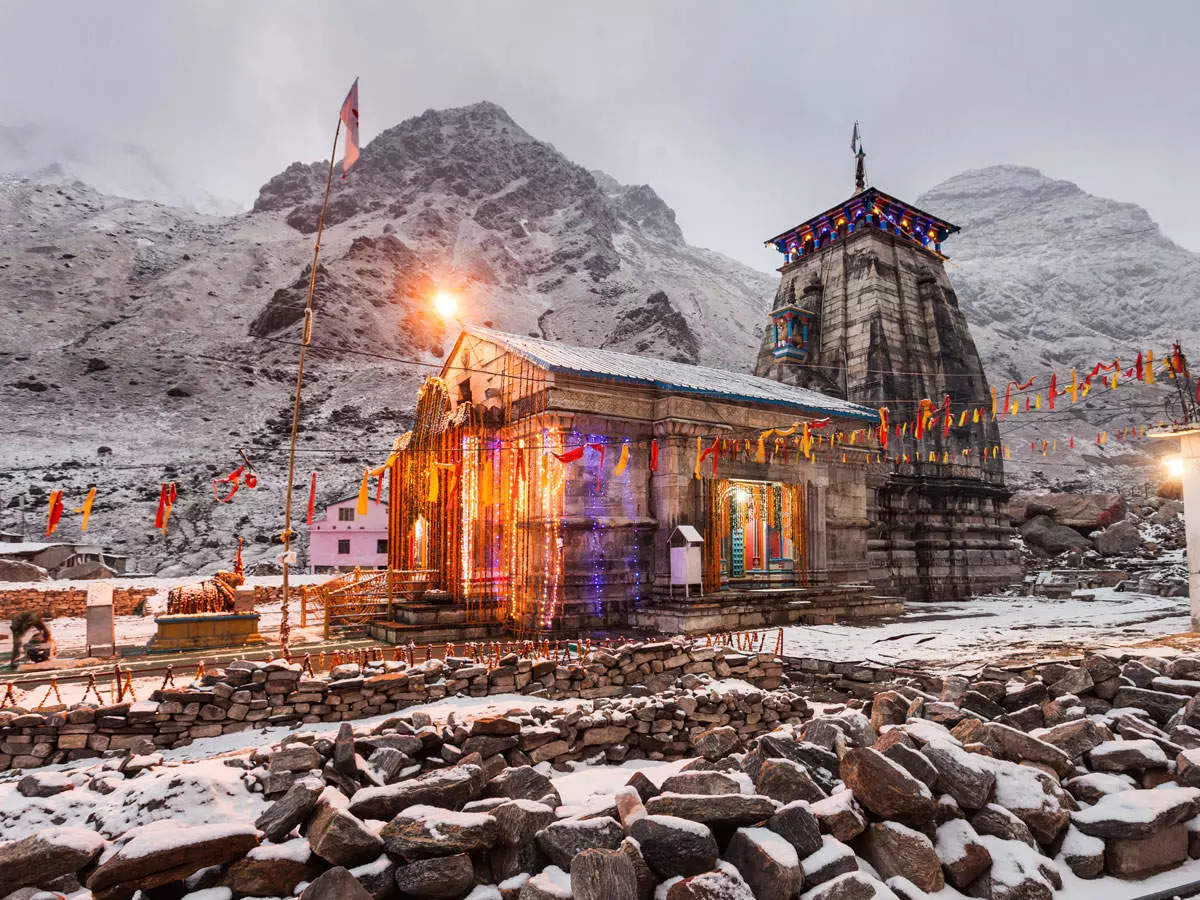Kedarnath Temple is a revered Hindu temple dedicated to Lord Shiva and is situated in the Garhwal Himalayan range in the Rudraprayag district of Uttarakhand, India. It holds immense significance in Hindu mythology and is one of the twelve Jyotirlingas, which are considered to be the holiest shrines dedicated to Lord Shiva.
The temple is located at an altitude of about 3,583 meters (11,755 feet) above sea level near the head of the Mandakini River. Due to its remote location in the midst of the Himalayas, the temple is only accessible for about six months each year, usually from late April to early November, as it remains snowbound during the rest of the year.
The origin of the Kedarnath Temple is rooted in ancient legends, with various mythological stories associated with it. The temple structure was believed to have been built by Adi Shankaracharya in the 8th century. However, the temple as it stands today is said to have been constructed by the Pandavas from the Mahabharata epic. It’s believed that after the Kurukshetra war, the Pandavas sought forgiveness from Lord Shiva for their sins of killing their own kin, and Shiva eluded them. Later, Shiva took refuge in Kedarnath in the form of a bull, and when pursued, the parts of his body appeared in various locations — his hump appeared in Kedarnath, and this is where the temple is situated.
The temple, constructed in the traditional Kedarnath style, is made of large, heavy, and evenly cut gray stones. The sanctum sanctorum of the temple houses a conical rock formation that is worshipped as Lord Shiva in his Sadashiva form.
Pilgrims from all over the world visit Kedarnath to seek the blessings of Lord Shiva. The trek to the temple is considered a part of the religious journey and is seen as a significant spiritual endeavor. Along with its religious importance, the surrounding natural beauty of the Himalayas adds to the spiritual experience for the visitors.
Kedarnath Temple has faced challenges throughout history, including destruction and reconstruction due to various natural calamities, with the most recent and significant one being the devastating floods in 2013 that caused significant damage to the region, including the temple. Since then, extensive efforts have been made for its reconstruction and restoration to welcome pilgrims once again.
Table of Content
History
The history of the Kedarnath Temple is deeply entrenched in Hindu mythology and ancient texts, with various legends and stories associated with its origin and significance.
The temple’s history is often linked to the Mahabharata, one of the two major Sanskrit epics of ancient India. According to Hindu mythology, the Pandavas, after the Kurukshetra War, sought penitence for killing their own kin. They wished to meet Lord Shiva to absolve themselves of the sin of fratricide. However, Lord Shiva was unwilling to grant them an audience and avoided appearing before them. Consequently, he transformed into a bull and went into hiding.
The parts of Shiva’s body, as the legend goes, appeared at different locations in the Himalayas. The hump appeared at Kedarnath, where the present-day temple is situated. This site is believed to be where Lord Shiva assumed the form of a bull, known as the “hump of the bull.”
The original construction of the temple is attributed to the Pandavas, who built it as a tribute to Lord Shiva. The temple was later revived and renovated by Adi Shankaracharya, the renowned 8th-century Hindu philosopher and theologian who is credited with establishing the four mathas in different parts of India and for revitalizing Hinduism.
Kedarnath Temple has faced various challenges throughout history, including natural disasters and invasions, leading to damage and subsequent restoration. It has been reconstructed several times due to destruction caused by avalanches, snow, and earthquakes, and its resilience and significance have kept it a central pilgrimage site for devotees.
One of the significant challenges the temple faced in recent times was during the devastating floods that struck the region in June 2013. The catastrophic flood, triggered by heavy rainfall and cloudburst, caused extensive damage to infrastructure, including the temple and its surroundings. The temple complex suffered significant destruction, but the sanctum sanctorum, housing the main deity, remained intact.
Efforts for the restoration and reconstruction of the Kedarnath Temple and the surrounding areas were subsequently initiated, aiming to restore the revered site and reinstate its sanctity for pilgrims and visitors. The reconstruction was a massive undertaking involving various government bodies, NGOs, and local authorities. The refurbished temple was reopened to the public after significant renovation efforts. This calamity, although tragic, brought about renewed efforts to strengthen and restore this sacred site.
Yearly Festivals
Kedarnath Temple hosts several festivals throughout the year, which draw numerous devotees and pilgrims. Some of the major yearly festivals celebrated at Kedarnath Temple include:
Mahashivaratri: This is one of the most significant festivals at Kedarnath and is celebrated with immense fervor. It falls in the Hindu month of Phalgun (February or March). Devotees throng the temple to offer special prayers and perform rituals in honor of Lord Shiva.
Rudra Abhishek: This is a ceremonial worship conducted with the chanting of Vedic hymns and mantras. It is performed to pay homage to Lord Shiva. Devotees offer sacred items like milk, water, honey, and belpatra (leaves of the wood apple tree) to the deity during this ritual.
Kedarnath Temple Opening and Closing Ceremonies: Due to its location in the Himalayas, Kedarnath Temple remains closed for approximately six months during the winter season when the region is snowbound and inaccessible. The opening and closing ceremonies mark the commencement and conclusion of the temple’s annual schedule. The temple reopens its doors to pilgrims around late April or early May, and the closing ceremony happens around October or November.
Shravan Month Celebrations: The month of Shravan (usually falling in July or August) holds great significance for Lord Shiva’s devotees. Special prayers, pujas, and rituals are conducted during this auspicious month at Kedarnath Temple.
Deepavali (Diwali): Diwali, the festival of lights, is also celebrated at Kedarnath Temple. Devotees visit the temple to seek the blessings of Lord Shiva on this occasion.
These festivals and celebrations hold immense religious and cultural significance, attracting devotees and tourists alike from different parts of the country and the world. They offer an opportunity for devotees to connect spiritually and partake in the rich traditions associated with the worship of Lord Shiva at Kedarnath Temple.
Daily Pujas
The daily rituals and pujas at the Kedarnath Temple are performed with great reverence and follow a structured schedule, aligning with traditional Hindu practices. The temple opens for pilgrims during the limited months when the region is accessible, typically from late April to early November, and the daily routine involves various ceremonies and worship practices. However, due to the temple’s remote location and climatic conditions, these timings might vary, and it’s best to confirm the schedule on-site or from reliable sources when planning a visit. Here is an outline of the general daily pujas and rituals:
Morning Puja (Pratah Kaal): The temple opens early in the morning, usually before sunrise. The priests perform the morning rituals, including bathing the lingam (the sacred symbol of Lord Shiva) with holy water, followed by the performance of various prayers and hymns dedicated to Lord Shiva.
Abhishekam (Ritual Bathing): An important part of the daily worship involves the ritualistic bathing (abhishekam) of the lingam with water, milk, ghee, honey, and other sacred liquids amidst the chanting of mantras.
Madhyana Puja (Midday Puja):This puja is performed around noon, and it involves offering prayers, incense, flowers, and other offerings to the deity.
Sandhya Aarti (Evening Aarti):
As the evening approaches, a grand aarti (a ritual of worship with light) takes place. This involves the waving of lighted lamps in front of the deity, along with the singing of hymns and the offering of bhog (food) to the deity.
Shringar Darshan:
After the Sandhya Aarti, the temple doors open for devotees to have the shringar darshan, where the deity is adorned with special clothes, jewelry, and decorations.
Rituals and Temple Closure:
After the evening aarti and darshan, the temple doors are closed, marking the end of the day’s public rituals.
The priests and temple authorities strictly adhere to these routines and maintain the sanctity of the rituals. Devotees often participate in these ceremonies, offer prayers, and receive blessings.
Visitors are recommended to maintain decorum and respect the traditions and customs of the temple. The timings and specific details of these pujas might vary or be subject to change, so it’s advisable to confirm the schedule from the temple authorities or through reliable sources before planning a visit to witness or participate in these rituals.
How To Reach
Reaching Kedarnath Temple involves a journey that typically combines various modes of transportation due to its remote and high-altitude location in the Garhwal Himalayas. Here’s a general overview of how to reach Kedarnath Temple:
By Air:
The nearest airport to Kedarnath is the Jolly Grant Airport in Dehradun, Uttarakhand. From there, one can take a flight to Dehradun and then proceed to Kedarnath via road or helicopter.
By Train:
The nearest major railway station is Haridwar, which is well-connected with various parts of India. From Haridwar, you can continue your journey to Kedarnath by road or helicopter.
By Road:
After reaching either Dehradun or Haridwar, the primary mode of reaching Kedarnath is by road. One can travel by bus, car, or taxi to Gaurikund, which is the base camp for the Kedarnath trek.
Trekking:
From Gaurikund, pilgrims need to trek about 16 kilometers (approximately 10 miles) to reach Kedarnath Temple. The trekking distance might vary due to road conditions and temporary alternate routes. The trek route passes through picturesque landscapes and small settlements. One can walk or hire mules or palanquins for the journey.
Helicopter Services:
There are helicopter services available from Phata, Guptkashi, and other nearby areas to Kedarnath. These services offer a faster way to reach the temple, cutting down the trekking time significantly.
Pony/Mule Services:
For those who might find it difficult to trek, there are pony and mule services available for hire from Gaurikund. These animals are used to carry pilgrims up the mountainous terrain.
Travel Considerations:
Weather conditions play a crucial role in the accessibility of Kedarnath. The temple is open for only a specific period during the year due to heavy snowfall and extreme weather conditions.
It’s advisable to check the opening and closing dates of the temple and the weather conditions before planning your visit.
During peak pilgrimage seasons, especially in the summer months, there might be heavy crowds, so planning and booking transportation in advance is recommended.
Before planning a trip to Kedarnath Temple, it’s advisable to check for the latest information on travel routes, weather conditions, and the temple’s operational status, as these can vary and might impact your journey.
Where To Stay
Accommodation options around the Kedarnath Temple are somewhat limited due to its remote and high-altitude location. The temple itself does not offer lodging facilities. However, there are some places to stay in the nearby areas:
Guptkashi: This is a town located around 30 km away from Gaurikund, the base for the trek to Kedarnath. Guptkashi offers a few hotels and guesthouses where you can stay before starting the trek.
Gaurikund: It serves as the starting point for the trek to Kedarnath. You might find a few accommodation options here, including guesthouses or basic lodges.
Rudraprayag: It’s a major town and district headquarters located about 76 km from Kedarnath. Rudraprayag offers a range of accommodation options including hotels, guesthouses, and lodges.
Sonprayag: It is around 5 km from Gaurikund and is another spot where you might find a few lodging options for pilgrims.
Jungle Camps/Tents: During the peak pilgrimage season, some temporary camps and tents are set up by the government or private operators along the trekking route to Kedarnath. These provide basic accommodation for the pilgrims.
Given the limited options, it’s advisable to plan and book accommodations in advance, especially during the peak pilgrimage season. Facilities might be basic in these locations due to the remote and high-altitude nature of the region.
Additionally, due to the environmental sensitivity and the pilgrimage’s popularity, regulations may change. It’s recommended to check the latest information and accommodations available before planning your visit to Kedarnath.




